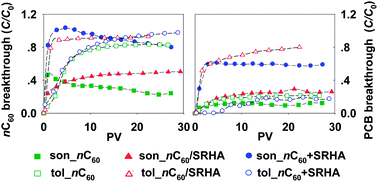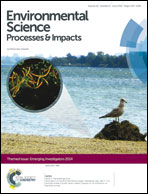Effects of the preparation method and humic-acid modification on the mobility and contaminant-mobilizing capability of fullerene nanoparticles (nC60)
Abstract
Colloidal fullerene nanoparticles (nC60) in aquatic environments may significantly affect the transport and risks of hydrophobic organic contaminants by serving as a contaminant carrier. The objective of this study was to understand how the combined variables of the preparation method and natural organic matter modification of nC60 might affect the mobility and contaminant-mobilizing capability of nC60, by affecting the physicochemical properties of nC60. We found that an nC60 sample prepared by sonicating C60 powder in deionized water (son_nC60) was much less mobile in saturated sandy soil columns than an nC60 sample prepared by solvent-exchanging from toluene to water (tol_nC60), because son_nC60 was considerably larger in size. However, son_nC60 exhibited greater capability to bind 2,2′,5,5′-polychlorinated biphenyl (PCB), likely because its loosely packed structures rendered more pore spaces, which were favorable adsorption sites for PCB. Forming nC60 samples in Suwannee River humic acid (SRHA) solution (instead of deionized water) only moderately affected the mobility of nC60, but had very significant effects on the contaminant-binding capability of nC60, especially when nC60 was prepared using the solvent exchange method. Adding SRHA after the formation of nC60 had varied effects on the mobility and contaminant-binding capability of nC60, but the fundamental mechanism seems to be linked to how and to what extent SRHA had affected the aggregation/packing of C60 monomers. An important environmental implication is that nC60 formed under different environmental conditions might have vastly different effects on contaminant transport and risks.


 Please wait while we load your content...
Please wait while we load your content...